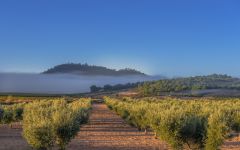Casa Castillo El Molar 2019
-
Robert
Parker



Product Details
Your Rating
Somm Note
Winemaker Notes
While Garnacha has been grown in Jumilla for centuries it has never been taken quite as seriously as Monstrell and most of it has been blended with other varieties. This seems all the more remarkable considering how closely the terroir of Jumilla resembles that of the Southern Rhone – hot, dry summers and a limestone subsoil topped with gravel. A few years back Jose Maria planted Garnacha in some of his most gravelly soils as an experiment. Named for the mountain with overshadows his property, El Molar is fermented whole cluster with indigenous yeasts and spends 12 months in neutral 500L French oak demi-muids resulting in a wine that is pale, fresh and aromatic – a promising new directing for the property and the DO.
Professional Ratings
-
Robert Parker's Wine Advocate
The Garnacha bottling from 2019, the 2019 El Molar, was produced with the grapes from three plots of vines planted on gravel and sandy soils covered with tosca stones planted in 2004, 2006 and 2010. 2019 was marked by torrential rains on September 13th that changed everything, but the Garnacha (and the Syrah) were harvested before the rain, so this wine is from a "normal" Mediterranean vintage. Fifty percent full clusters were used for the native fermentation in underground stone pools with a short maceration. It matured in 500-liter oak barrels and 5,000-liter oak vats for 12 months. It's a little lower in alcohol but shows ripeness (without excess), but the core is floral, perfumed and elegant. The tannins are very fine-grained with the essence of the limestone soils, that chalky quality of the texture. Very impressive for a 2019. 26,000 bottles produced. It was bottled in December 2020. Best after 2022.
Other Vintages
2021-
Robert
Parker
-
Robert
Parker
-
Robert
Parker
-
Robert
Parker
-
Robert
Parker
-
Robert
Parker -
James
Suckling
-
James
Suckling





The Roch family acquired the property in 1941. Julia Roch and her grandson, José Maria Vicente, have been recovering the artisanal origins of this estate, making significant strides in the integrity and quality of winemaking.
